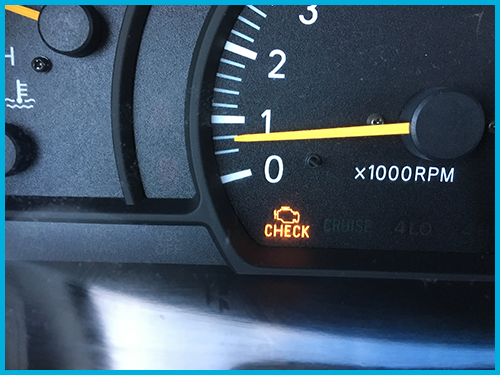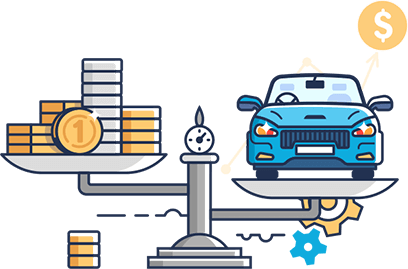For every seller, there’s a buyer. So, chances are, someone is willing to buy your car, even if the check engine light is on.
However, this is one of many “red flags” that sellers look for when purchasing a vehicle. Seeing this light on the dashboard may prompt them to offer less than the original asking price or otherwise walk away from the sale.
If you’re thinking of selling your car, you should understand the implications that a check engine light can have on the sale.
One thing you should know immediately is that you have options. Even if you can’t find an individual buyer online, you could sell the car to a specialized service.
Who Buys Cars With the Check Engine Light On?
There are thousands of people online who have no problem purchasing cars that have the check engine light on.
However, for those looking for a fast and easy sale, finding the right buyer can turn into a stressful experience. Instead of stressing about your options, you could sell the car to:
A junkyard. Even clunker cars are filled with precious metals that can fetch a high price. This is especially true in today’s economy, where the cost of copper, brass, and platinum has increased.
A dealership. Some dealerships will purchase any car, regardless of its condition. You could trade in your car and use those credits to offset the cost of a new vehicle. Yet, keep in mind that dealerships sometimes buy used cars, then sell them to junkyards. You might want to cut out “the middleman” and contact a junkyard directly.
CarBrain. With CarBrain, selling a car with the check engine light has never been easier. With the push of a button, you’re guaranteed to get an offer on your car, regardless of its condition. What’s more, you don’t even have to leave your house. CarBrain handles all towing services.
An online buyer. Selling a car online can quickly turn into a hassle. You could have your inbox flooded with notifications, all of them offering less than you asked for. You could also have to deal with endless negotiating, only to come to a stalemate. Sometimes, you really are playing the lottery when posting your car on social media or other forums.
Why Is the Check Engine Light On?
There are many reasons why a car’s check engine light may come on––some of which aren’t worth addressing.
For instance, some vehicles will have the check engine light on if the gas cap isn’t screwed all the way. Others might have this light on if the mechanic performs work and doesn’t turn the sensor off.
Per Kelley Blue Book (KBB), some reasons behind a dreaded check engine light include malfunctioning:
Oxygen sensors
Spark plugs
Mass airflow sensors
Fuel injectors
Catalytic converters
Evaporator emissions purge valves
Most user manuals will advise car owners to consult a mechanic when the check engine light comes on. This manual could be in your glovebox, or you could find a copy online.
Solid Check Engine Lights vs. Flashing Check Engine Lights
A check engine light doesn’t necessarily spell disaster. Here are two things to consider:
A solid check engine light generally points to a non-emergency problem. For instance, if the gas cap isn’t tightened enough, this light may turn on. If you suspect this is an issue, and the gas cap is already tight, the sensor may need replacing.
A flashing check engine light means you need to take your car to a mechanic immediately. If unaddressed, the car could break down or otherwise become unsafe to drive.
Some mechanics and automotive stores offer free diagnostic exams. Here, you could learn whether your check engine light requires a small fix or a major overhaul.
Common Reasons for a Honda Check Engine Light
Hondas are known for being sturdy vehicles that don’t routinely have problems. This means, if the check engine light comes on, it likely needs a professional’s help.
Some reasons behind a Honda’s check engine light include:
Faulty spark plugs. Spark plugs create a jolt of electricity that helps ignite your vehicle’s engine. When these components are faulty or need replacing, a solid check engine light might come on. If unaddressed, the car might not start.
A problematic fuel injector. A fuel injector does exactly what it sounds like; it injects fuel into the car’s internal combustion engine. When it doesn’t work, the car may feel as though it’s sputtering.
A missing or malfunctioning catalytic converter. A catalytic converter converts your car’s toxic gasses into air that’s less polluted. If the check engine light is on, and the car is relatively new, this could mean that someone stole this component. Catalytic converters can fetch high prices at chop shops.
Common Reasons for a Toyota Check Engine Light
Just like Hondas, Toyotas have a great reputation as sturdy vehicles. They generally don’t run into problems aside from those that come with general wear and tear.
Yet, the check engine light may come on if:
The oxygen sensor stops working. The oxygen sensor is a short cable that measures how much unburned fuel is in the tailpipe. This helps your car’s engine work properly.
The mass airflow sensor has problems. Like the oxygen sensor, this component also measures gas levels. However, these devices work with the car’s computer to determine a proper air-fuel mixture.
Evaporator emissions purge valves don’t work properly. These devices prevent gas in the fuel tank from evaporating. While this problem wouldn’t threaten a driver’s safety per se, it will hurt the car’s fuel economy, prompting frequent visits to the gas station.
How to Reset a Check Engine Light
Usually, when the mechanic fixes the problem, the car’s engine light turns off automatically. Still, they may have to reset the diagnostic sensor.
This process varies from car to car, but it generally involves disconnecting the negative battery cable, waiting a few seconds, then plugging it back in.
This effectively restarts the diagnostic system, ideally turning the light off. If the light remains on, this could mean that the underlying problem was not resolved.
CarBrain Buys Cars With Their Check Engine Lights On
CarBrain has great news for people who want to sell their cars: it doesn’t matter if the check engine light is on.
By entering in some basic details about your case, you could get a cash offer in seconds. If you accept, we could be in your driveway in less than two days.
Here’s what to expect when you accept an offer from our team:
We work out a time to pick up your car. We work around your schedule, not the other way around. You don’t have to take any time from your busy schedule to get your car towed.
You give us two things. When we come to tow your car, we just need two things: the car’s keys and the title. Of course, we also need access to your vehicle, so we can get in and get out.
You get cash. Once we pick up your car, you can get payment deposited into your account. We aim to make selling your car as easy and straightforward as possible.
You don’t have to deal with shady dealerships or unreliable buyers online. With CarBrain, you can breathe easy knowing that we’re handling everything.




